Marketing Strategies of Hilton Hotel in UK: A Comprehensive Analysis
VerifiedAdded on 2022/04/15
|26
|5367
|60
Report
AI Summary
This report provides a comprehensive analysis of the marketing strategies employed by Hilton Hotel, focusing on its operations within the UK market. The study begins with an executive summary, followed by an introduction outlining the complexities of marketing in the service sector and the importance of dynamic strategies. It then presents the company background, tracing Hilton's evolution from its inception to its current global leadership position, highlighting key innovations and market dominance. The methodology section explains the use of secondary data and literature review to analyze the hotel's marketing approach. A detailed situational analysis, based on the marketing mix (product, brand, functionality, price, place, and promotion), is provided. The report also includes an analysis using Michael Porter's Competitive Forces Model, PEST analysis, and SWOT analysis of Hilton's UK operations. Finally, the report suggests strategic objectives and marketing strategies, such as introducing middle-class services, embracing innovation, and diversification to enhance competitiveness. The report concludes with a summary of findings and recommendations for future growth.
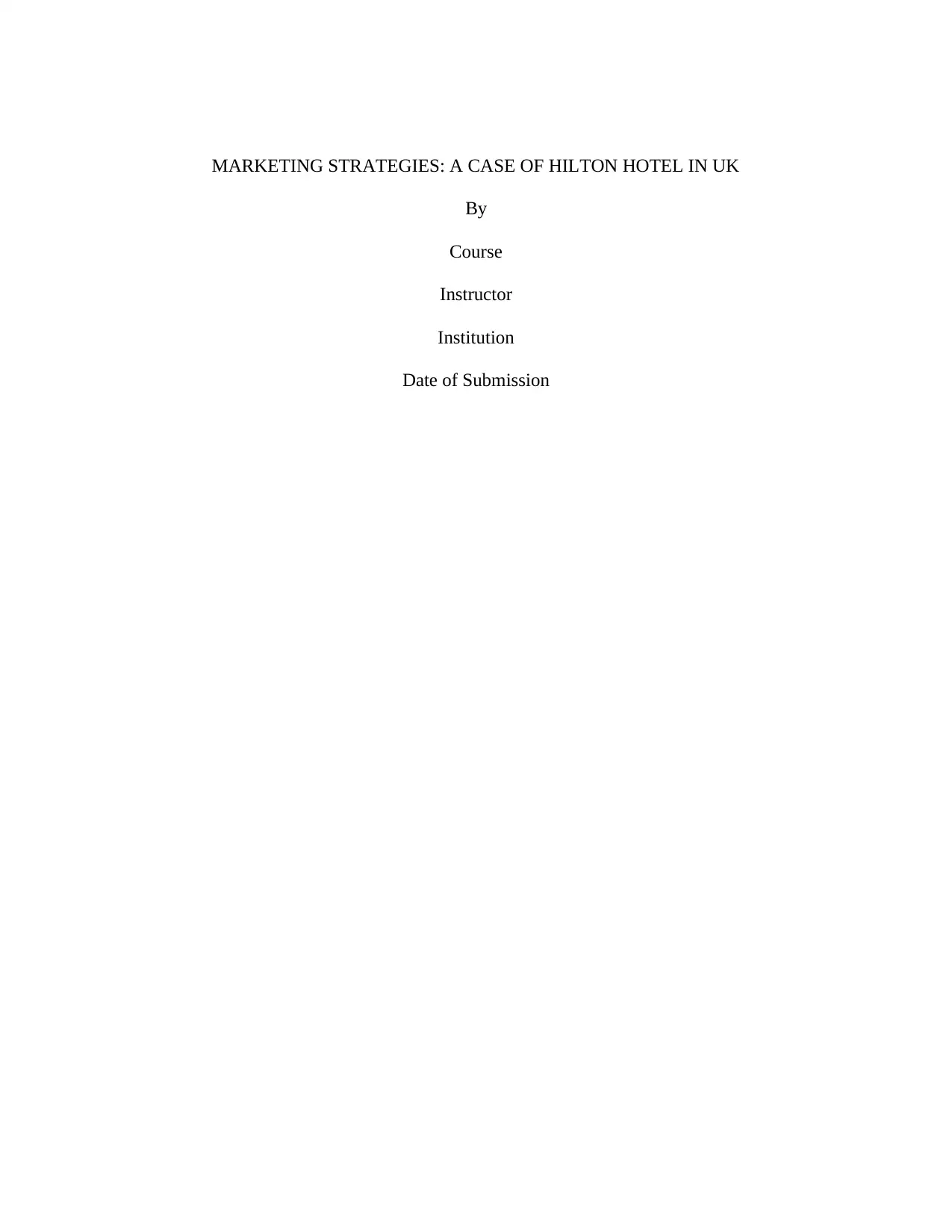
MARKETING STRATEGIES: A CASE OF HILTON HOTEL IN UK
By
Course
Instructor
Institution
Date of Submission
By
Course
Instructor
Institution
Date of Submission
Paraphrase This Document
Need a fresh take? Get an instant paraphrase of this document with our AI Paraphraser
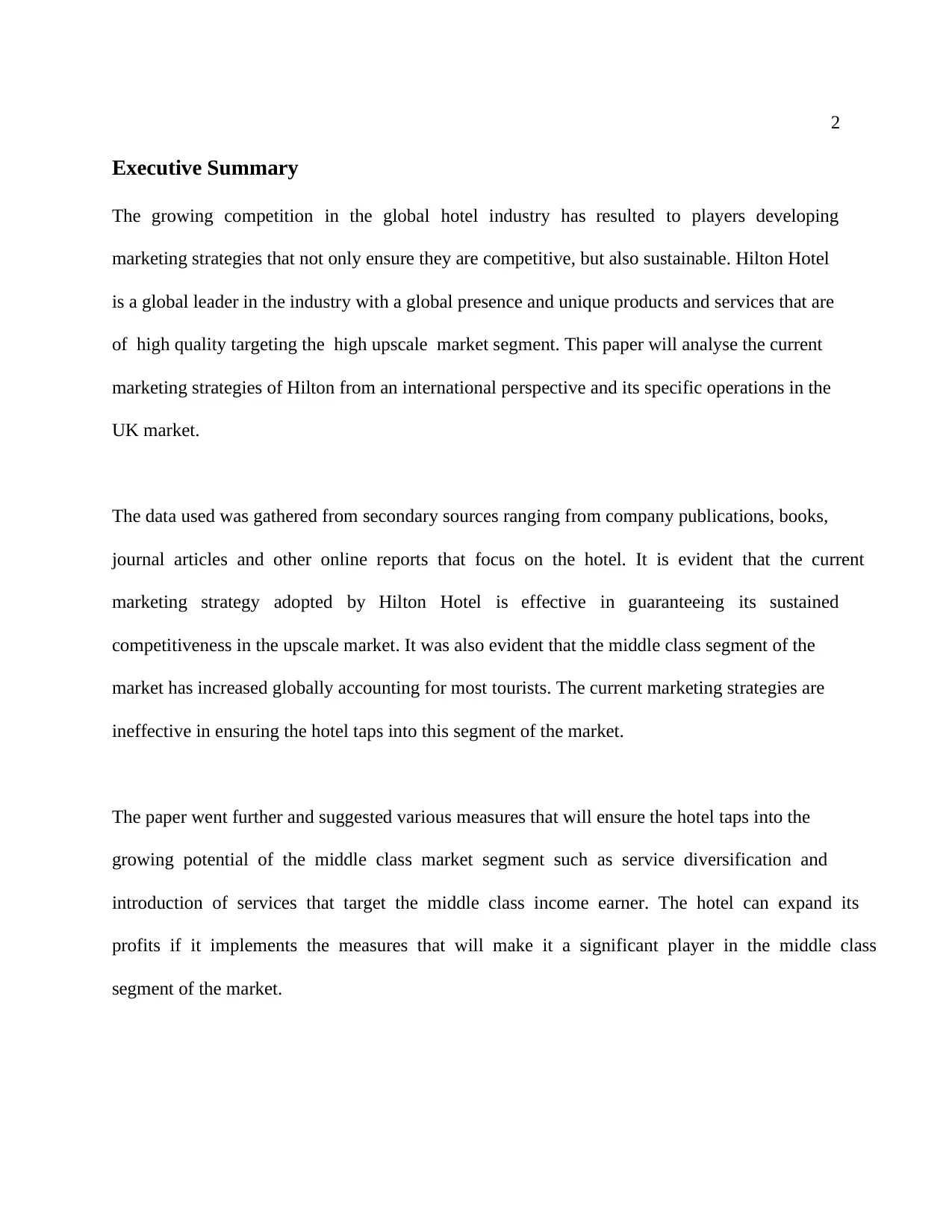
2
Executive Summary
The growing competition in the global hotel industry has resulted to players developing
marketing strategies that not only ensure they are competitive, but also sustainable. Hilton Hotel
is a global leader in the industry with a global presence and unique products and services that are
of high quality targeting the high upscale market segment. This paper will analyse the current
marketing strategies of Hilton from an international perspective and its specific operations in the
UK market.
The data used was gathered from secondary sources ranging from company publications, books,
journal articles and other online reports that focus on the hotel. It is evident that the current
marketing strategy adopted by Hilton Hotel is effective in guaranteeing its sustained
competitiveness in the upscale market. It was also evident that the middle class segment of the
market has increased globally accounting for most tourists. The current marketing strategies are
ineffective in ensuring the hotel taps into this segment of the market.
The paper went further and suggested various measures that will ensure the hotel taps into the
growing potential of the middle class market segment such as service diversification and
introduction of services that target the middle class income earner. The hotel can expand its
profits if it implements the measures that will make it a significant player in the middle class
segment of the market.
Executive Summary
The growing competition in the global hotel industry has resulted to players developing
marketing strategies that not only ensure they are competitive, but also sustainable. Hilton Hotel
is a global leader in the industry with a global presence and unique products and services that are
of high quality targeting the high upscale market segment. This paper will analyse the current
marketing strategies of Hilton from an international perspective and its specific operations in the
UK market.
The data used was gathered from secondary sources ranging from company publications, books,
journal articles and other online reports that focus on the hotel. It is evident that the current
marketing strategy adopted by Hilton Hotel is effective in guaranteeing its sustained
competitiveness in the upscale market. It was also evident that the middle class segment of the
market has increased globally accounting for most tourists. The current marketing strategies are
ineffective in ensuring the hotel taps into this segment of the market.
The paper went further and suggested various measures that will ensure the hotel taps into the
growing potential of the middle class market segment such as service diversification and
introduction of services that target the middle class income earner. The hotel can expand its
profits if it implements the measures that will make it a significant player in the middle class
segment of the market.
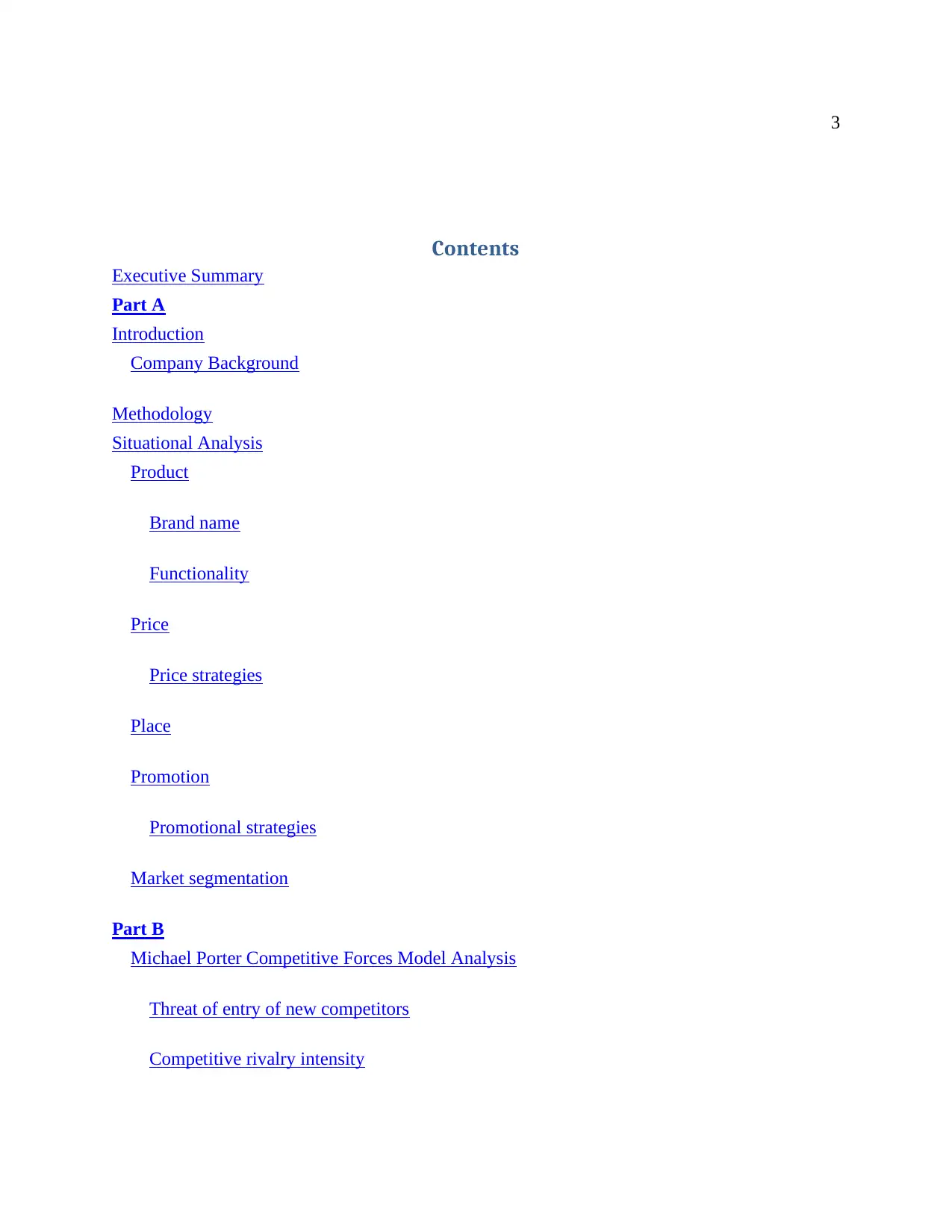
3
Contents
Executive Summary
Part A
Introduction
Company Background
Methodology
Situational Analysis
Product
Brand name
Functionality
Price
Price strategies
Place
Promotion
Promotional strategies
Market segmentation
Part B
Michael Porter Competitive Forces Model Analysis
Threat of entry of new competitors
Competitive rivalry intensity
Contents
Executive Summary
Part A
Introduction
Company Background
Methodology
Situational Analysis
Product
Brand name
Functionality
Price
Price strategies
Place
Promotion
Promotional strategies
Market segmentation
Part B
Michael Porter Competitive Forces Model Analysis
Threat of entry of new competitors
Competitive rivalry intensity
⊘ This is a preview!⊘
Do you want full access?
Subscribe today to unlock all pages.

Trusted by 1+ million students worldwide
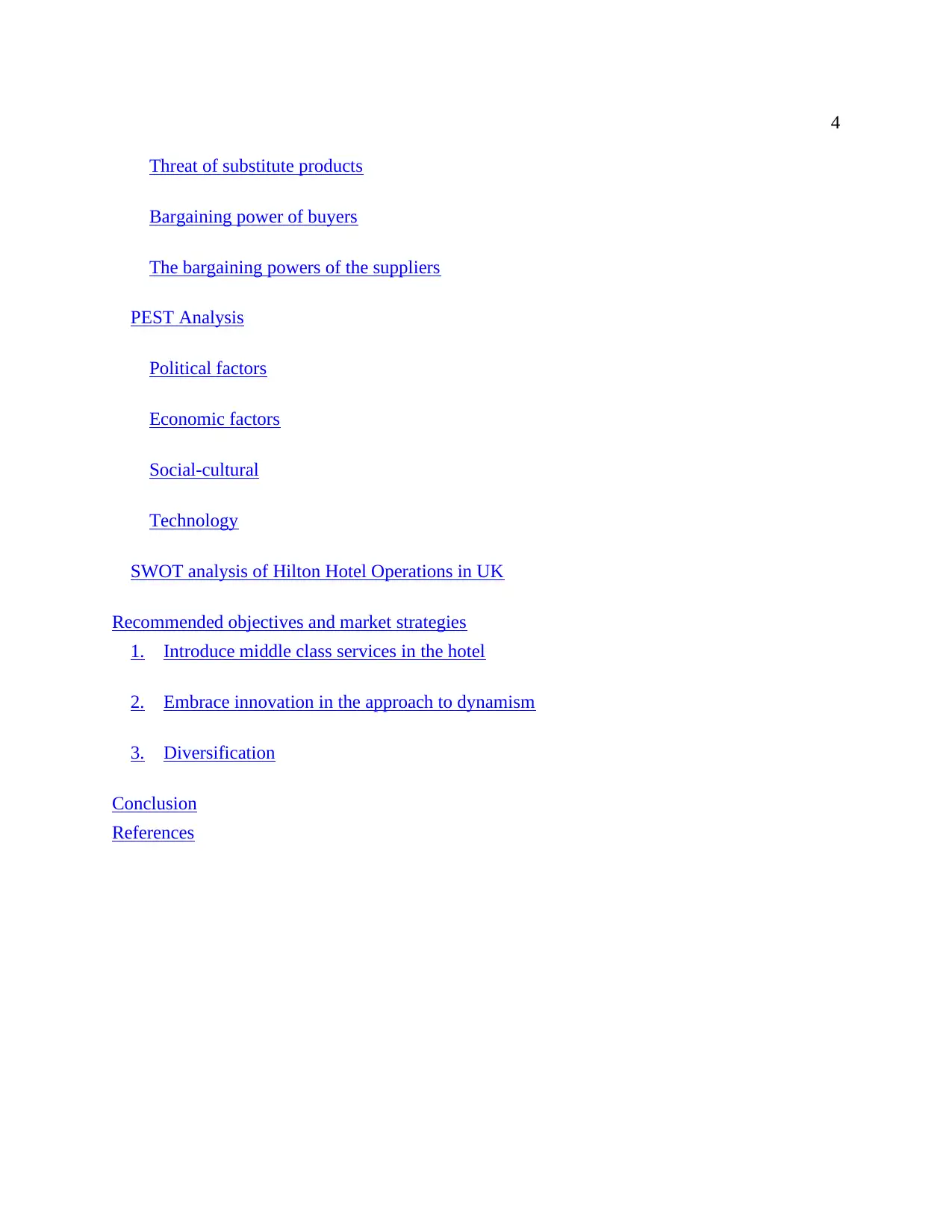
4
Threat of substitute products
Bargaining power of buyers
The bargaining powers of the suppliers
PEST Analysis
Political factors
Economic factors
Social-cultural
Technology
SWOT analysis of Hilton Hotel Operations in UK
Recommended objectives and market strategies
1. Introduce middle class services in the hotel
2. Embrace innovation in the approach to dynamism
3. Diversification
Conclusion
References
Threat of substitute products
Bargaining power of buyers
The bargaining powers of the suppliers
PEST Analysis
Political factors
Economic factors
Social-cultural
Technology
SWOT analysis of Hilton Hotel Operations in UK
Recommended objectives and market strategies
1. Introduce middle class services in the hotel
2. Embrace innovation in the approach to dynamism
3. Diversification
Conclusion
References
Paraphrase This Document
Need a fresh take? Get an instant paraphrase of this document with our AI Paraphraser
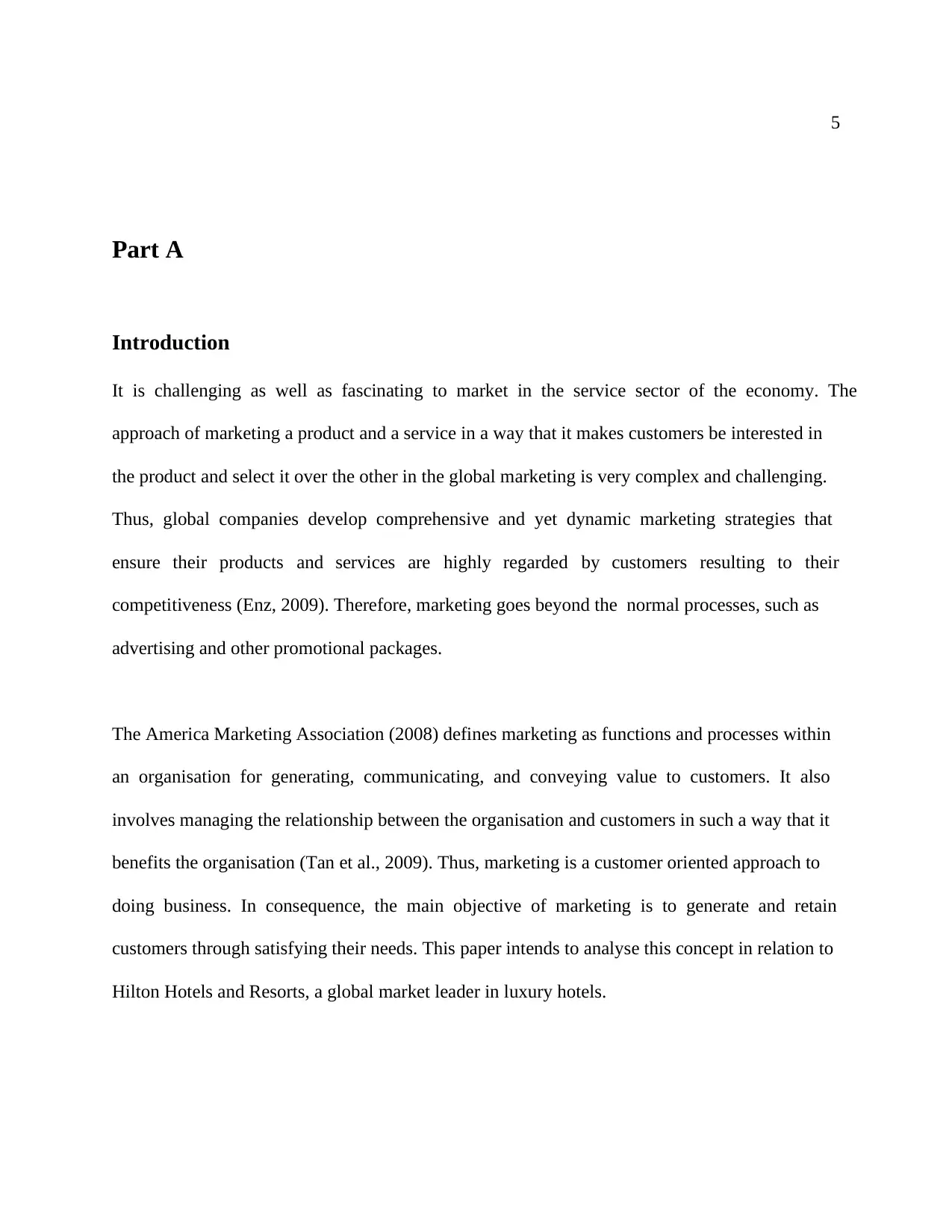
5
Part A
Introduction
It is challenging as well as fascinating to market in the service sector of the economy. The
approach of marketing a product and a service in a way that it makes customers be interested in
the product and select it over the other in the global marketing is very complex and challenging.
Thus, global companies develop comprehensive and yet dynamic marketing strategies that
ensure their products and services are highly regarded by customers resulting to their
competitiveness (Enz, 2009). Therefore, marketing goes beyond the normal processes, such as
advertising and other promotional packages.
The America Marketing Association (2008) defines marketing as functions and processes within
an organisation for generating, communicating, and conveying value to customers. It also
involves managing the relationship between the organisation and customers in such a way that it
benefits the organisation (Tan et al., 2009). Thus, marketing is a customer oriented approach to
doing business. In consequence, the main objective of marketing is to generate and retain
customers through satisfying their needs. This paper intends to analyse this concept in relation to
Hilton Hotels and Resorts, a global market leader in luxury hotels.
Part A
Introduction
It is challenging as well as fascinating to market in the service sector of the economy. The
approach of marketing a product and a service in a way that it makes customers be interested in
the product and select it over the other in the global marketing is very complex and challenging.
Thus, global companies develop comprehensive and yet dynamic marketing strategies that
ensure their products and services are highly regarded by customers resulting to their
competitiveness (Enz, 2009). Therefore, marketing goes beyond the normal processes, such as
advertising and other promotional packages.
The America Marketing Association (2008) defines marketing as functions and processes within
an organisation for generating, communicating, and conveying value to customers. It also
involves managing the relationship between the organisation and customers in such a way that it
benefits the organisation (Tan et al., 2009). Thus, marketing is a customer oriented approach to
doing business. In consequence, the main objective of marketing is to generate and retain
customers through satisfying their needs. This paper intends to analyse this concept in relation to
Hilton Hotels and Resorts, a global market leader in luxury hotels.
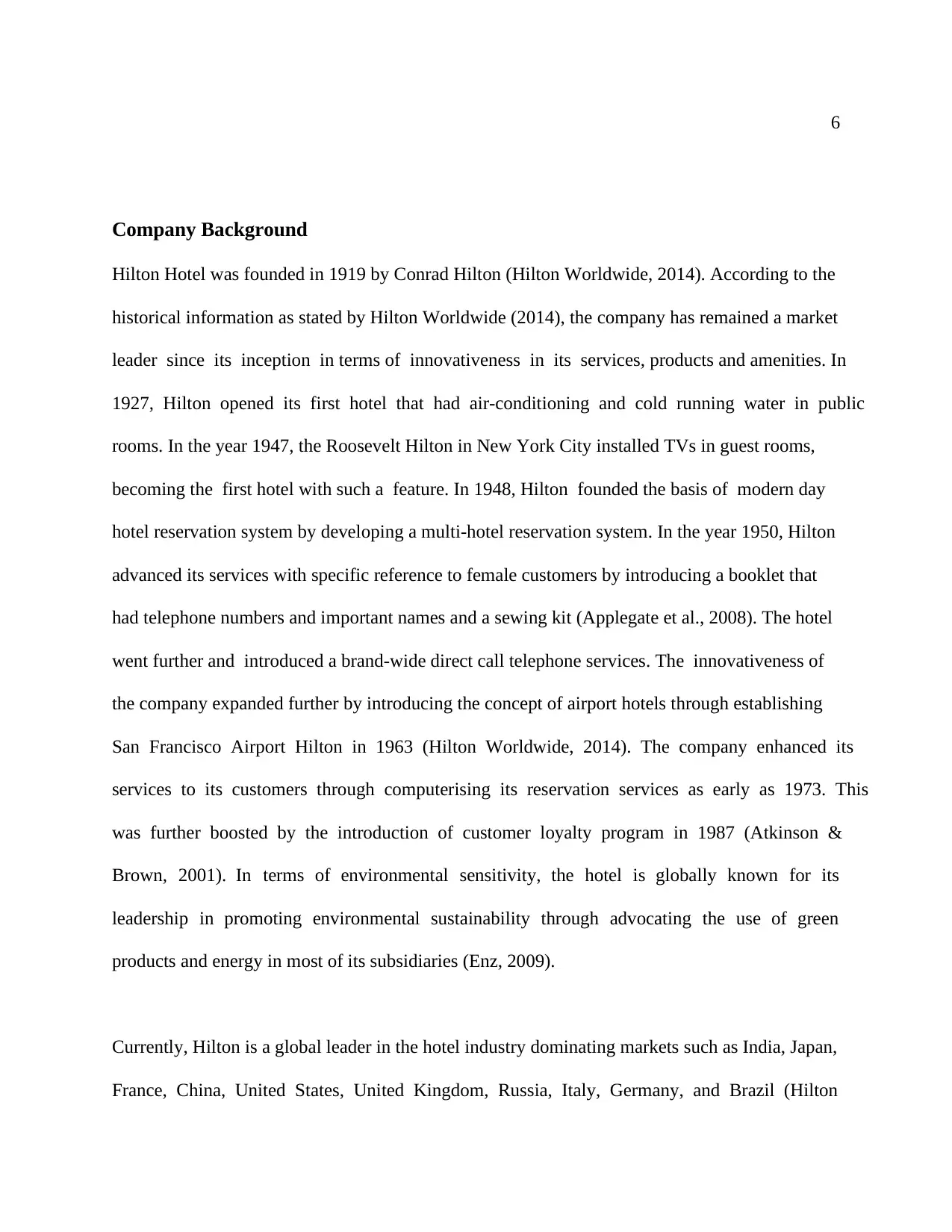
6
Company Background
Hilton Hotel was founded in 1919 by Conrad Hilton (Hilton Worldwide, 2014). According to the
historical information as stated by Hilton Worldwide (2014), the company has remained a market
leader since its inception in terms of innovativeness in its services, products and amenities. In
1927, Hilton opened its first hotel that had air-conditioning and cold running water in public
rooms. In the year 1947, the Roosevelt Hilton in New York City installed TVs in guest rooms,
becoming the first hotel with such a feature. In 1948, Hilton founded the basis of modern day
hotel reservation system by developing a multi-hotel reservation system. In the year 1950, Hilton
advanced its services with specific reference to female customers by introducing a booklet that
had telephone numbers and important names and a sewing kit (Applegate et al., 2008). The hotel
went further and introduced a brand-wide direct call telephone services. The innovativeness of
the company expanded further by introducing the concept of airport hotels through establishing
San Francisco Airport Hilton in 1963 (Hilton Worldwide, 2014). The company enhanced its
services to its customers through computerising its reservation services as early as 1973. This
was further boosted by the introduction of customer loyalty program in 1987 (Atkinson &
Brown, 2001). In terms of environmental sensitivity, the hotel is globally known for its
leadership in promoting environmental sustainability through advocating the use of green
products and energy in most of its subsidiaries (Enz, 2009).
Currently, Hilton is a global leader in the hotel industry dominating markets such as India, Japan,
France, China, United States, United Kingdom, Russia, Italy, Germany, and Brazil (Hilton
Company Background
Hilton Hotel was founded in 1919 by Conrad Hilton (Hilton Worldwide, 2014). According to the
historical information as stated by Hilton Worldwide (2014), the company has remained a market
leader since its inception in terms of innovativeness in its services, products and amenities. In
1927, Hilton opened its first hotel that had air-conditioning and cold running water in public
rooms. In the year 1947, the Roosevelt Hilton in New York City installed TVs in guest rooms,
becoming the first hotel with such a feature. In 1948, Hilton founded the basis of modern day
hotel reservation system by developing a multi-hotel reservation system. In the year 1950, Hilton
advanced its services with specific reference to female customers by introducing a booklet that
had telephone numbers and important names and a sewing kit (Applegate et al., 2008). The hotel
went further and introduced a brand-wide direct call telephone services. The innovativeness of
the company expanded further by introducing the concept of airport hotels through establishing
San Francisco Airport Hilton in 1963 (Hilton Worldwide, 2014). The company enhanced its
services to its customers through computerising its reservation services as early as 1973. This
was further boosted by the introduction of customer loyalty program in 1987 (Atkinson &
Brown, 2001). In terms of environmental sensitivity, the hotel is globally known for its
leadership in promoting environmental sustainability through advocating the use of green
products and energy in most of its subsidiaries (Enz, 2009).
Currently, Hilton is a global leader in the hotel industry dominating markets such as India, Japan,
France, China, United States, United Kingdom, Russia, Italy, Germany, and Brazil (Hilton
⊘ This is a preview!⊘
Do you want full access?
Subscribe today to unlock all pages.

Trusted by 1+ million students worldwide
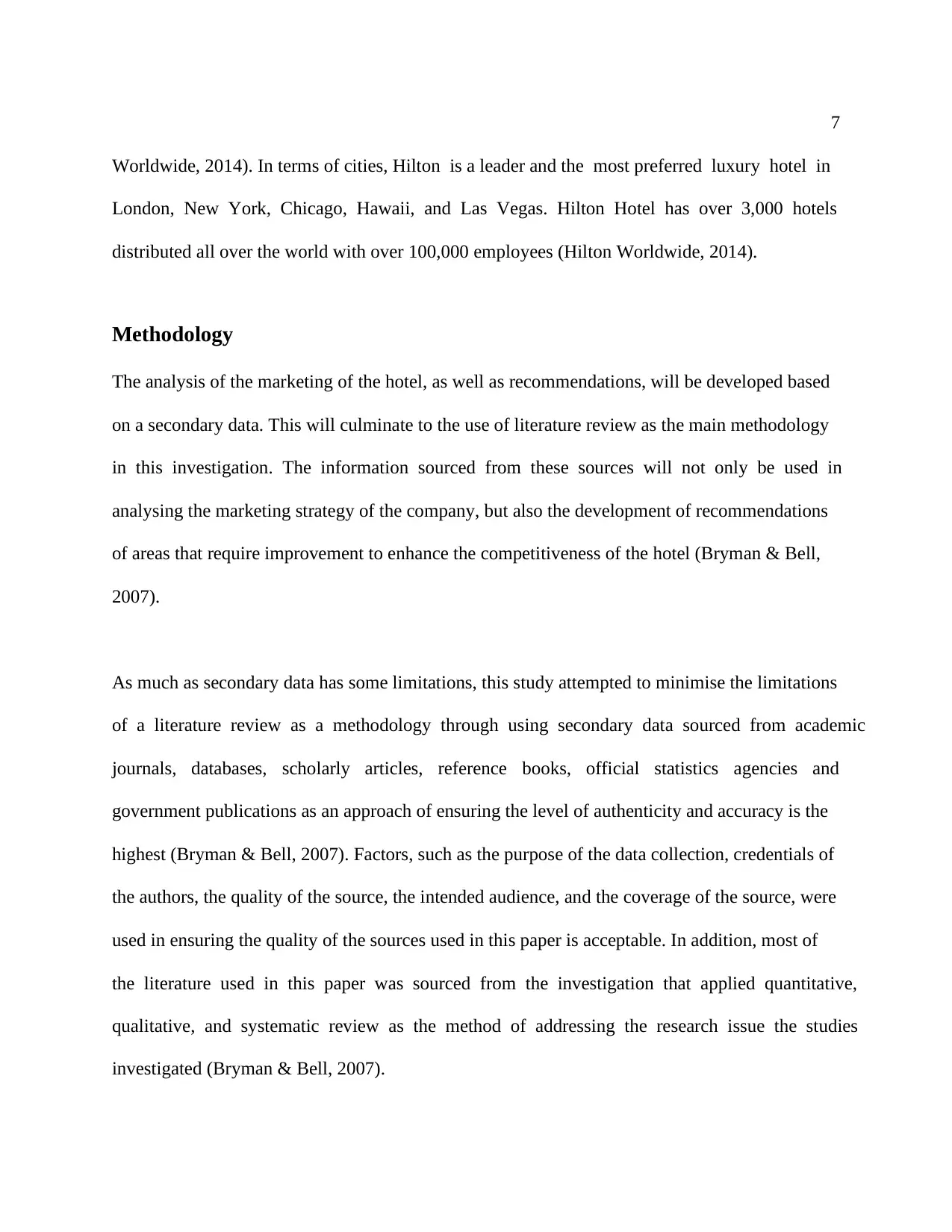
7
Worldwide, 2014). In terms of cities, Hilton is a leader and the most preferred luxury hotel in
London, New York, Chicago, Hawaii, and Las Vegas. Hilton Hotel has over 3,000 hotels
distributed all over the world with over 100,000 employees (Hilton Worldwide, 2014).
Methodology
The analysis of the marketing of the hotel, as well as recommendations, will be developed based
on a secondary data. This will culminate to the use of literature review as the main methodology
in this investigation. The information sourced from these sources will not only be used in
analysing the marketing strategy of the company, but also the development of recommendations
of areas that require improvement to enhance the competitiveness of the hotel (Bryman & Bell,
2007).
As much as secondary data has some limitations, this study attempted to minimise the limitations
of a literature review as a methodology through using secondary data sourced from academic
journals, databases, scholarly articles, reference books, official statistics agencies and
government publications as an approach of ensuring the level of authenticity and accuracy is the
highest (Bryman & Bell, 2007). Factors, such as the purpose of the data collection, credentials of
the authors, the quality of the source, the intended audience, and the coverage of the source, were
used in ensuring the quality of the sources used in this paper is acceptable. In addition, most of
the literature used in this paper was sourced from the investigation that applied quantitative,
qualitative, and systematic review as the method of addressing the research issue the studies
investigated (Bryman & Bell, 2007).
Worldwide, 2014). In terms of cities, Hilton is a leader and the most preferred luxury hotel in
London, New York, Chicago, Hawaii, and Las Vegas. Hilton Hotel has over 3,000 hotels
distributed all over the world with over 100,000 employees (Hilton Worldwide, 2014).
Methodology
The analysis of the marketing of the hotel, as well as recommendations, will be developed based
on a secondary data. This will culminate to the use of literature review as the main methodology
in this investigation. The information sourced from these sources will not only be used in
analysing the marketing strategy of the company, but also the development of recommendations
of areas that require improvement to enhance the competitiveness of the hotel (Bryman & Bell,
2007).
As much as secondary data has some limitations, this study attempted to minimise the limitations
of a literature review as a methodology through using secondary data sourced from academic
journals, databases, scholarly articles, reference books, official statistics agencies and
government publications as an approach of ensuring the level of authenticity and accuracy is the
highest (Bryman & Bell, 2007). Factors, such as the purpose of the data collection, credentials of
the authors, the quality of the source, the intended audience, and the coverage of the source, were
used in ensuring the quality of the sources used in this paper is acceptable. In addition, most of
the literature used in this paper was sourced from the investigation that applied quantitative,
qualitative, and systematic review as the method of addressing the research issue the studies
investigated (Bryman & Bell, 2007).
Paraphrase This Document
Need a fresh take? Get an instant paraphrase of this document with our AI Paraphraser
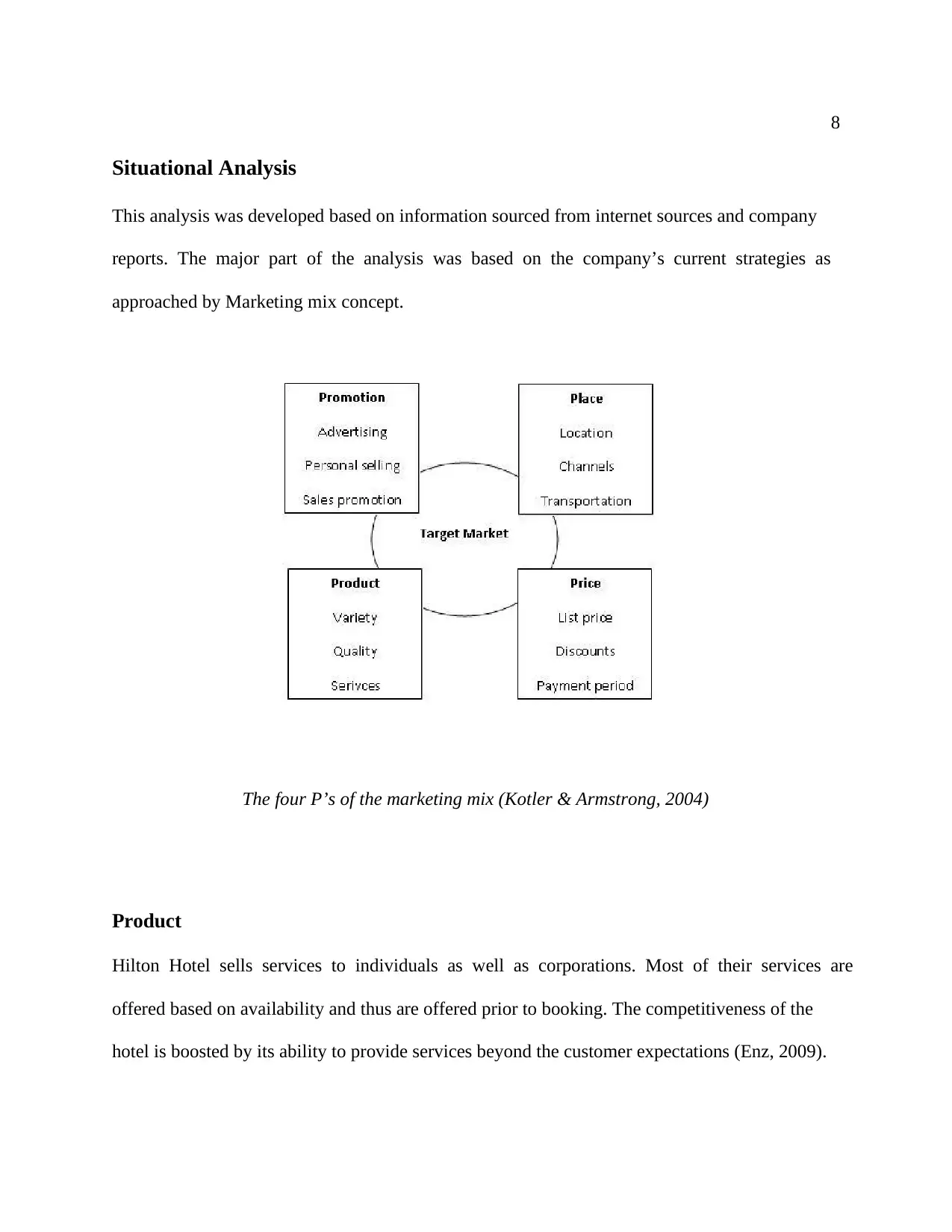
8
Situational Analysis
This analysis was developed based on information sourced from internet sources and company
reports. The major part of the analysis was based on the company’s current strategies as
approached by Marketing mix concept.
The four P’s of the marketing mix (Kotler & Armstrong, 2004)
Product
Hilton Hotel sells services to individuals as well as corporations. Most of their services are
offered based on availability and thus are offered prior to booking. The competitiveness of the
hotel is boosted by its ability to provide services beyond the customer expectations (Enz, 2009).
Situational Analysis
This analysis was developed based on information sourced from internet sources and company
reports. The major part of the analysis was based on the company’s current strategies as
approached by Marketing mix concept.
The four P’s of the marketing mix (Kotler & Armstrong, 2004)
Product
Hilton Hotel sells services to individuals as well as corporations. Most of their services are
offered based on availability and thus are offered prior to booking. The competitiveness of the
hotel is boosted by its ability to provide services beyond the customer expectations (Enz, 2009).
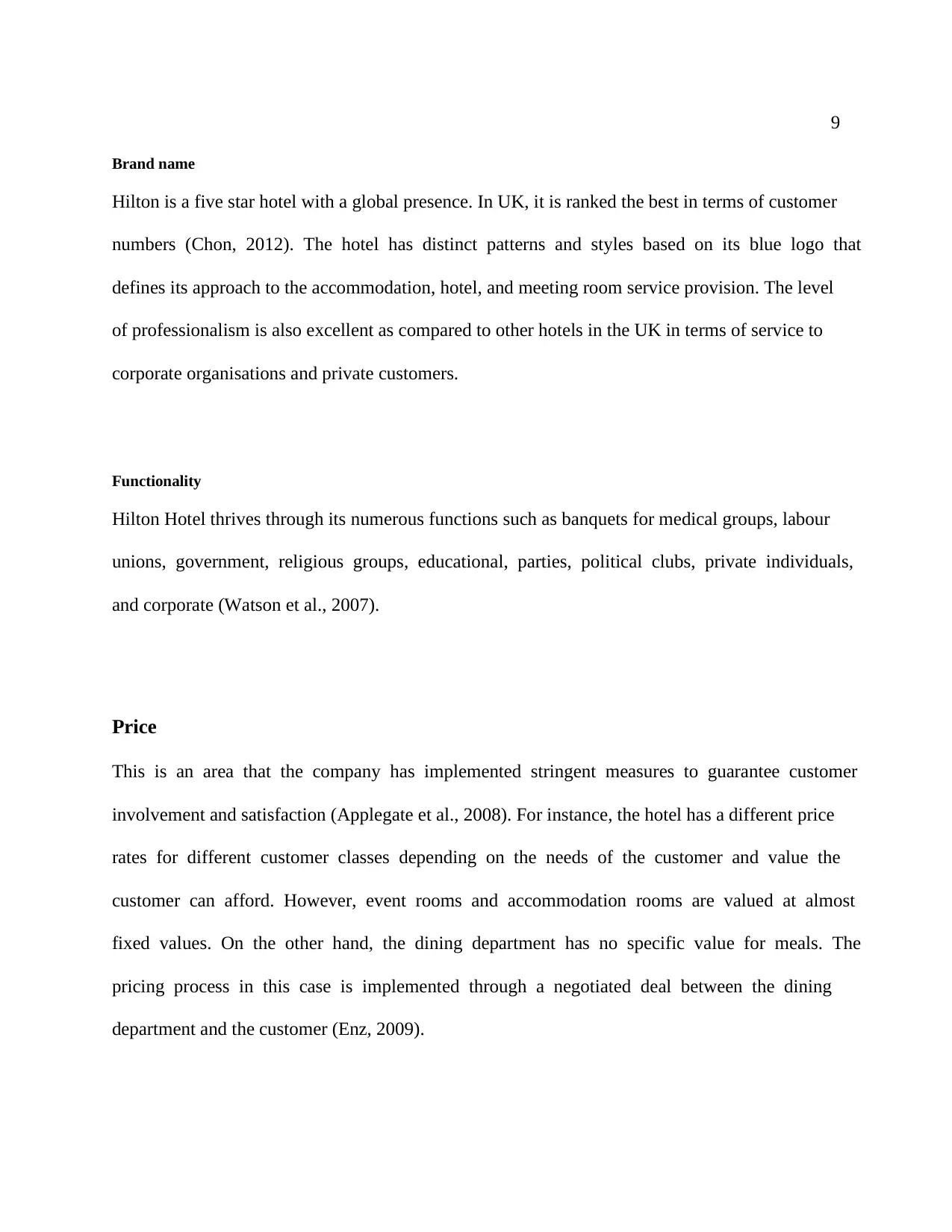
9
Brand name
Hilton is a five star hotel with a global presence. In UK, it is ranked the best in terms of customer
numbers (Chon, 2012). The hotel has distinct patterns and styles based on its blue logo that
defines its approach to the accommodation, hotel, and meeting room service provision. The level
of professionalism is also excellent as compared to other hotels in the UK in terms of service to
corporate organisations and private customers.
Functionality
Hilton Hotel thrives through its numerous functions such as banquets for medical groups, labour
unions, government, religious groups, educational, parties, political clubs, private individuals,
and corporate (Watson et al., 2007).
Price
This is an area that the company has implemented stringent measures to guarantee customer
involvement and satisfaction (Applegate et al., 2008). For instance, the hotel has a different price
rates for different customer classes depending on the needs of the customer and value the
customer can afford. However, event rooms and accommodation rooms are valued at almost
fixed values. On the other hand, the dining department has no specific value for meals. The
pricing process in this case is implemented through a negotiated deal between the dining
department and the customer (Enz, 2009).
Brand name
Hilton is a five star hotel with a global presence. In UK, it is ranked the best in terms of customer
numbers (Chon, 2012). The hotel has distinct patterns and styles based on its blue logo that
defines its approach to the accommodation, hotel, and meeting room service provision. The level
of professionalism is also excellent as compared to other hotels in the UK in terms of service to
corporate organisations and private customers.
Functionality
Hilton Hotel thrives through its numerous functions such as banquets for medical groups, labour
unions, government, religious groups, educational, parties, political clubs, private individuals,
and corporate (Watson et al., 2007).
Price
This is an area that the company has implemented stringent measures to guarantee customer
involvement and satisfaction (Applegate et al., 2008). For instance, the hotel has a different price
rates for different customer classes depending on the needs of the customer and value the
customer can afford. However, event rooms and accommodation rooms are valued at almost
fixed values. On the other hand, the dining department has no specific value for meals. The
pricing process in this case is implemented through a negotiated deal between the dining
department and the customer (Enz, 2009).
⊘ This is a preview!⊘
Do you want full access?
Subscribe today to unlock all pages.

Trusted by 1+ million students worldwide
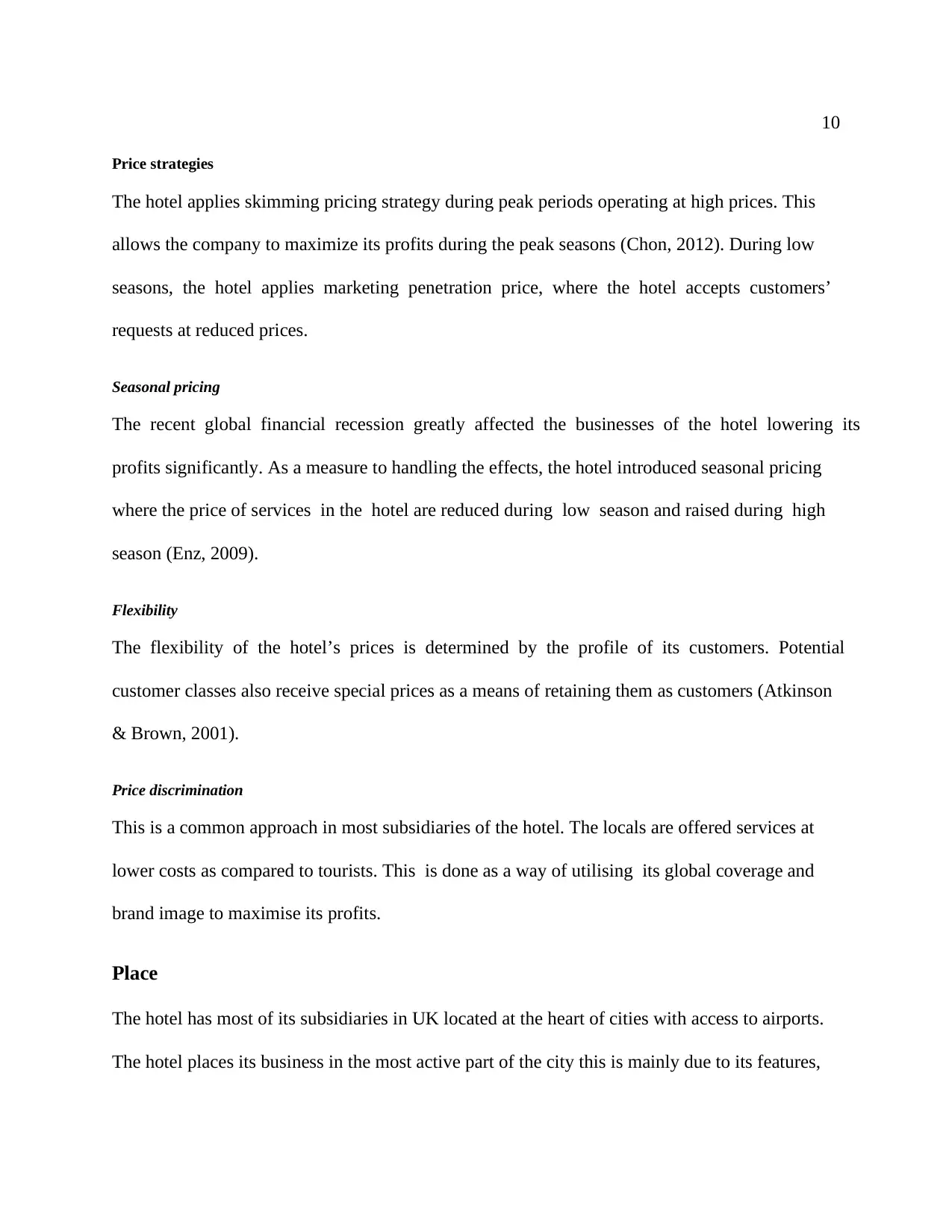
10
Price strategies
The hotel applies skimming pricing strategy during peak periods operating at high prices. This
allows the company to maximize its profits during the peak seasons (Chon, 2012). During low
seasons, the hotel applies marketing penetration price, where the hotel accepts customers’
requests at reduced prices.
Seasonal pricing
The recent global financial recession greatly affected the businesses of the hotel lowering its
profits significantly. As a measure to handling the effects, the hotel introduced seasonal pricing
where the price of services in the hotel are reduced during low season and raised during high
season (Enz, 2009).
Flexibility
The flexibility of the hotel’s prices is determined by the profile of its customers. Potential
customer classes also receive special prices as a means of retaining them as customers (Atkinson
& Brown, 2001).
Price discrimination
This is a common approach in most subsidiaries of the hotel. The locals are offered services at
lower costs as compared to tourists. This is done as a way of utilising its global coverage and
brand image to maximise its profits.
Place
The hotel has most of its subsidiaries in UK located at the heart of cities with access to airports.
The hotel places its business in the most active part of the city this is mainly due to its features,
Price strategies
The hotel applies skimming pricing strategy during peak periods operating at high prices. This
allows the company to maximize its profits during the peak seasons (Chon, 2012). During low
seasons, the hotel applies marketing penetration price, where the hotel accepts customers’
requests at reduced prices.
Seasonal pricing
The recent global financial recession greatly affected the businesses of the hotel lowering its
profits significantly. As a measure to handling the effects, the hotel introduced seasonal pricing
where the price of services in the hotel are reduced during low season and raised during high
season (Enz, 2009).
Flexibility
The flexibility of the hotel’s prices is determined by the profile of its customers. Potential
customer classes also receive special prices as a means of retaining them as customers (Atkinson
& Brown, 2001).
Price discrimination
This is a common approach in most subsidiaries of the hotel. The locals are offered services at
lower costs as compared to tourists. This is done as a way of utilising its global coverage and
brand image to maximise its profits.
Place
The hotel has most of its subsidiaries in UK located at the heart of cities with access to airports.
The hotel places its business in the most active part of the city this is mainly due to its features,
Paraphrase This Document
Need a fresh take? Get an instant paraphrase of this document with our AI Paraphraser
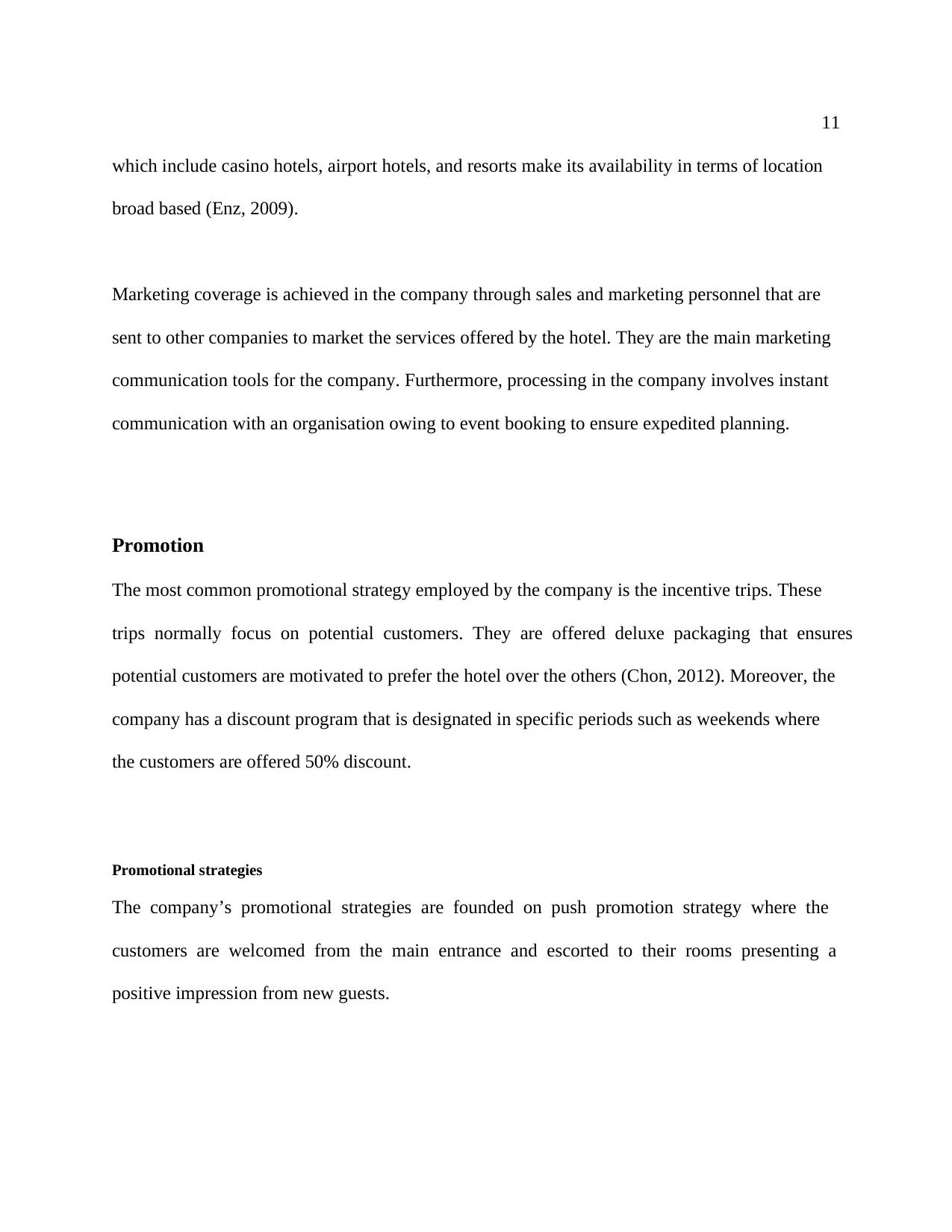
11
which include casino hotels, airport hotels, and resorts make its availability in terms of location
broad based (Enz, 2009).
Marketing coverage is achieved in the company through sales and marketing personnel that are
sent to other companies to market the services offered by the hotel. They are the main marketing
communication tools for the company. Furthermore, processing in the company involves instant
communication with an organisation owing to event booking to ensure expedited planning.
Promotion
The most common promotional strategy employed by the company is the incentive trips. These
trips normally focus on potential customers. They are offered deluxe packaging that ensures
potential customers are motivated to prefer the hotel over the others (Chon, 2012). Moreover, the
company has a discount program that is designated in specific periods such as weekends where
the customers are offered 50% discount.
Promotional strategies
The company’s promotional strategies are founded on push promotion strategy where the
customers are welcomed from the main entrance and escorted to their rooms presenting a
positive impression from new guests.
which include casino hotels, airport hotels, and resorts make its availability in terms of location
broad based (Enz, 2009).
Marketing coverage is achieved in the company through sales and marketing personnel that are
sent to other companies to market the services offered by the hotel. They are the main marketing
communication tools for the company. Furthermore, processing in the company involves instant
communication with an organisation owing to event booking to ensure expedited planning.
Promotion
The most common promotional strategy employed by the company is the incentive trips. These
trips normally focus on potential customers. They are offered deluxe packaging that ensures
potential customers are motivated to prefer the hotel over the others (Chon, 2012). Moreover, the
company has a discount program that is designated in specific periods such as weekends where
the customers are offered 50% discount.
Promotional strategies
The company’s promotional strategies are founded on push promotion strategy where the
customers are welcomed from the main entrance and escorted to their rooms presenting a
positive impression from new guests.
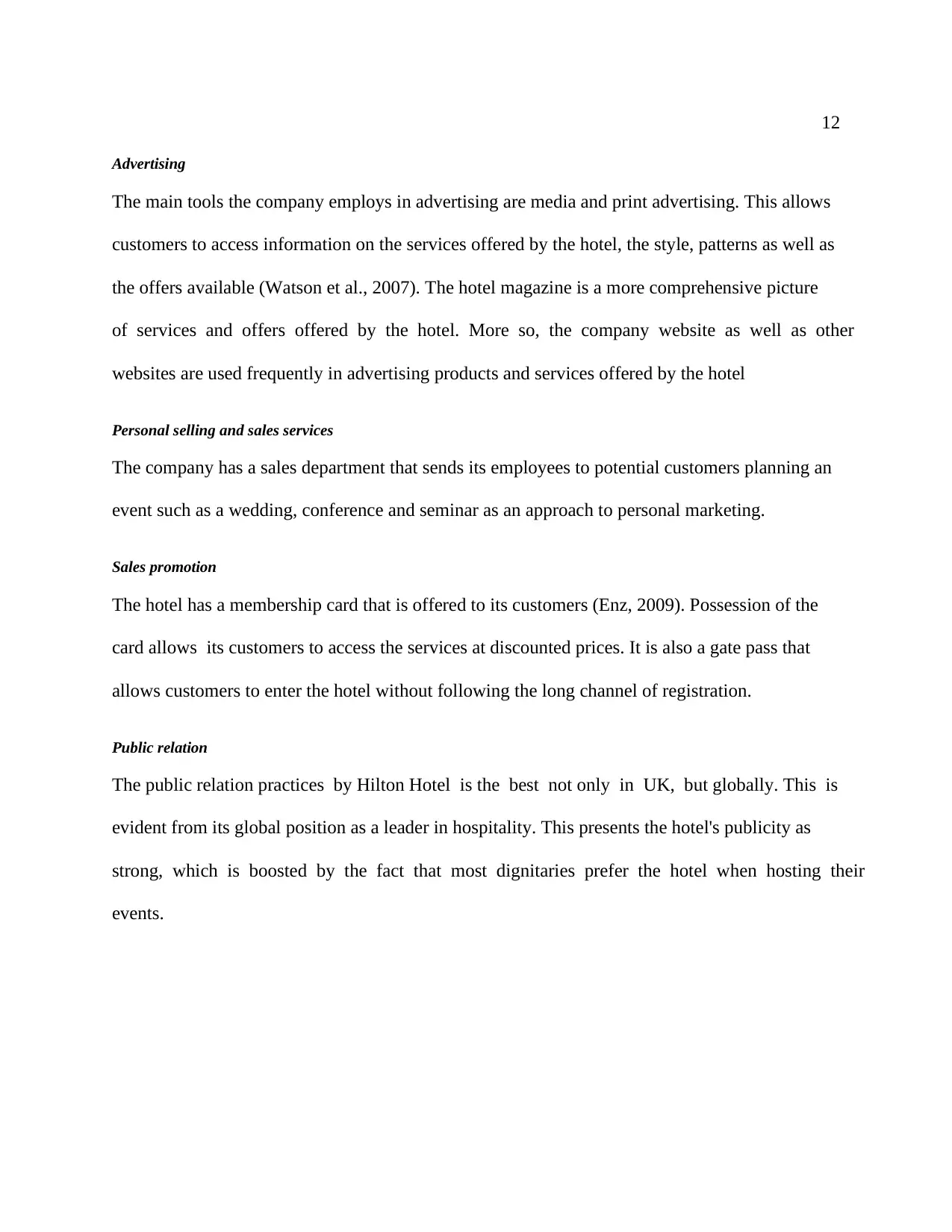
12
Advertising
The main tools the company employs in advertising are media and print advertising. This allows
customers to access information on the services offered by the hotel, the style, patterns as well as
the offers available (Watson et al., 2007). The hotel magazine is a more comprehensive picture
of services and offers offered by the hotel. More so, the company website as well as other
websites are used frequently in advertising products and services offered by the hotel
Personal selling and sales services
The company has a sales department that sends its employees to potential customers planning an
event such as a wedding, conference and seminar as an approach to personal marketing.
Sales promotion
The hotel has a membership card that is offered to its customers (Enz, 2009). Possession of the
card allows its customers to access the services at discounted prices. It is also a gate pass that
allows customers to enter the hotel without following the long channel of registration.
Public relation
The public relation practices by Hilton Hotel is the best not only in UK, but globally. This is
evident from its global position as a leader in hospitality. This presents the hotel's publicity as
strong, which is boosted by the fact that most dignitaries prefer the hotel when hosting their
events.
Advertising
The main tools the company employs in advertising are media and print advertising. This allows
customers to access information on the services offered by the hotel, the style, patterns as well as
the offers available (Watson et al., 2007). The hotel magazine is a more comprehensive picture
of services and offers offered by the hotel. More so, the company website as well as other
websites are used frequently in advertising products and services offered by the hotel
Personal selling and sales services
The company has a sales department that sends its employees to potential customers planning an
event such as a wedding, conference and seminar as an approach to personal marketing.
Sales promotion
The hotel has a membership card that is offered to its customers (Enz, 2009). Possession of the
card allows its customers to access the services at discounted prices. It is also a gate pass that
allows customers to enter the hotel without following the long channel of registration.
Public relation
The public relation practices by Hilton Hotel is the best not only in UK, but globally. This is
evident from its global position as a leader in hospitality. This presents the hotel's publicity as
strong, which is boosted by the fact that most dignitaries prefer the hotel when hosting their
events.
⊘ This is a preview!⊘
Do you want full access?
Subscribe today to unlock all pages.

Trusted by 1+ million students worldwide
1 out of 26
Related Documents
Your All-in-One AI-Powered Toolkit for Academic Success.
+13062052269
info@desklib.com
Available 24*7 on WhatsApp / Email
![[object Object]](/_next/static/media/star-bottom.7253800d.svg)
Unlock your academic potential
Copyright © 2020–2025 A2Z Services. All Rights Reserved. Developed and managed by ZUCOL.





